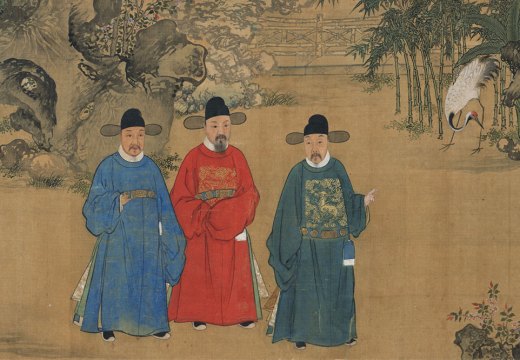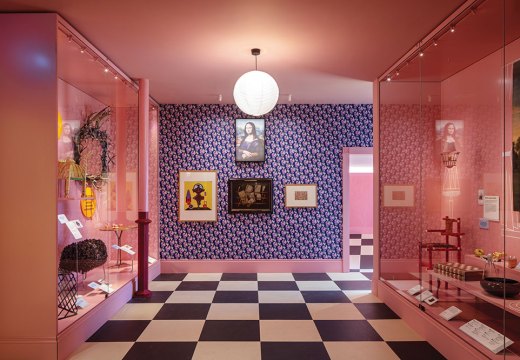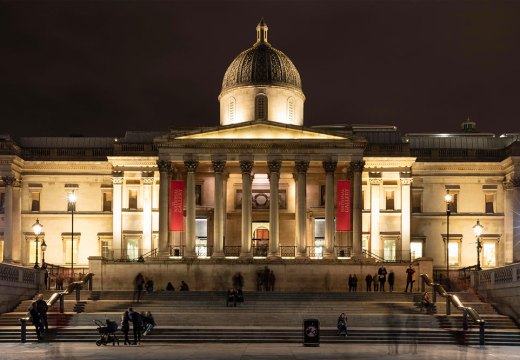From the September 2023 issue of Apollo. Preview and subscribe here.
Sarah Lucas made her name in London with bold, bawdy sculptures in the 1990s. Ahead of a retrospective at Tate Britain, she tells Apollo that swapping the city for rural Suffolk has led her to more primordial themes.
When did you start thinking about ‘Happy Gas’, your upcoming exhibition at Tate Britain?
Around September last year I thought I’d like to do a chairs show. I first used chairs in a piece in 1992. Back then, at two weeks’ notice, I was offered an empty shop on Kingly Street in Soho. It was under the umbrella of Alternative Arts. A friend of mine, Clare Palmier, was supposed to be doing the show there but something came up that meant she couldn’t, so she offered it to me. I had two pieces: Two Fried Eggs and a Kebab in the shop front and The Old Couple (two chairs) in a tiny room at the back. Since then chairs have featured a lot.
How involved are you in the curation and display of such an exhibition?
Very involved, I’d say. An exhibition is an artwork in itself. It’s a bit like staging a drama. This one is in four acts. The characters are all sculptures that somehow incorporate a chair. There are four main rooms. One of early works, one of recent pieces and the other two, representing the intervening years, are divided, loosely, into apocalyptic and pastoral themes. Two-dimensional works in the form of wallpapers, photographs and concrete walls make the backdrops and concrete blocks provide the stage.

The Old Couple (1992) Sarah Lucas. Private collection. Courtesy the artist and Sadie Coles HQ, London; © Sarah Lucas
Though your work is indelibly associated with urbanity, you’ve been living and working in rural Suffolk for about 15 years now. How has this affected your art?
I’ve become more interested in farming, I suppose, and roaming around on the land trying to imagine a time before agriculture became so industrialised. I’ve always used a lot of found objects – in the making of artworks and also to spark off ideas. Found objects in the countryside have a different character to their urban counterparts. A lot of fallen branches lying about like limbs and old tractor bits rusting away in fields. Roadkill.
Suffolk initially seemed a bit like the world time forgot, 20 or so years ago. Like slipping down a rabbit hole. Folk music and blokes in horses and carts, and people selling produce they’d grown from stalls outside their houses or out of the boots of cars on a Sunday afternoon at the pub. Some very dapper gentlemen in waistcoats and caps and neckerchiefs. A lot of the older farmers wore suits to farm in and long raincoats.
Others resembled scarecrows. My neighbour, William Hambling, for instance, would wear the same clothes for working in until they fell off him. He got attached to things he was comfortable in. And he made novel improvements. Cutting bits off if they got in his way – sleeves and collars. Wrapping up his knees in plastic tied with string. Very practical and inventive. He made good scarecrows, too. They looked just like him.

Sarah Lucas, photographed in Framlingham, Suffolk in 2023. Photo: Katie Morrison; courtesy Sadie Coles HQ, London; © Sarah Lucas
There was a spirit of freedom in the people around. And an absence of feeling watched or having to look over your shoulder. Not a lot of crime and not a lot of police, if any. A kind of idyll. It seemed like an alternative reality. I started to have a double life – one urban, one rural.
It struck me then how our outlook on life is heavily conditioned by the grim round of war, violence and catastrophe that the media constantly bombards us with. The diet of fear. I wondered: if I stopped looking at all that stuff, would it still be there? Would it make any difference at all to me, in my life, if I shift my focus away? Because there is this terrible appetite for it, isn’t there? Like needing a fix.
I did make one exhibition called ‘Penetralia’ [Sadie Coles HQ, London, 2008] that was based on things found in the landscape around here, mainly sticks and stones. It had a primordial feeling about it, which has become one theme or strand of what I’ve been doing since.
So many of your works derive their power from juxtapositions – the cigarettes and the plasterwork parts of womens’ bodies (as in the Muses series), fruit, veg, a bucket and a dirty mattress (Au Naturel, 1994), the headlines in your newspaper collages. Is this about seeing things and trying them out together, or looking for an answer to a problem?
It’s good when it’s an answer to a problem. That way there’s an honest answer – a right answer, even. Trouble is, is it a real question? Or even, what is the question? Does it need to be like that? Necessity is a difficult thing to dream up. Mostly, in life, it doesn’t need much dreaming up. It’s just something you’re stuck with. Making art, it does need to be invented. For me anyway. Why do it – and why do it that way?
Of course there will be a certain amount of givens to what can be achieved: what’s available to do it with at the time, what’s on hand, for instance. There are a lot of creative processes at work. Even just living – quite apart from making art. Particularly if you want to change your life at all. There are only so many things that can make a real change – your house, your partner or your job are the classic three. And then you have to consider the possibilities for action. For most people these may be more limited than the possibilities open to artists. In terms of what artists want to make, there’s great freedom – and that can also be one of the problems. The possibilities are infinite to the point of being a blank page. And yet, there will be given limitations. Time, space, money – in general. And the more specific ones of your situation at that moment.
I tend to look for a solution close to hand. Something immediate, as I’m an impatient person. While I’m stroking my chin I might think: ‘That will do to be getting on with.’ Occasionally: ‘Eureka!’
Some objects have become a part of my language – cigarettes, eggs, knobs. But that doesn’t mean their meaning is fixed. Meaning is always up for grabs.

Au Naturel (1994), Sarah Lucas. Private collection. Courtesy the artist and Sadie Coles HQ, London; © Sarah Lucas
You’ve said of your Bunny figures: ‘I made the first Bunny almost accidentally, meaning I didn’t have a clear idea of where I was heading with the tights I was stuffing. I hung them on the back of a chair to see how they were shaping up and Bunny stared back at me’. How do you know when something is finished?
Mainly when something about it isn’t bothering me. When something is bothering me, I carry on. If nothing’s bothering me then it’s either all right or I need to have it around for a while, in the corner of my eye, and see how I feel about it later on. Often I do think, ‘That’s it! Great!’, usually when something unexpected has happened. They were getting on my tits, so I slung them on a chair in the corner out of my way, say. Next day I came in and they’re looking back at me, totally convincing, from what was yesterday a random position. Also, when I’m making a body of work, it bears what it’s doing in relation to other pieces. A conversation gets going. Often I have to get some way along with a few things before it becomes clear what they’re supposed to be doing; individually, that is. Other things fall into place. Names. Attitudes. Switching the furniture. Turning it upside down. Something observed or overheard in the street.
The installing process of an exhibition can also be a time when particular works are solved, at least in their relation to each other – including works that were already solved, one way or another, years ago. Every exhibition is a new work in its own right. And new relationships and points of view are always possible. In fact, it almost never happens that exactly the same show happens again, let alone in the same space and certainly not in the same time – so it’s always going to be different. I like installing. It’s a good moment to have a fresh look.

Bunny Gets Snookered #3 (1997), Sarah Lucas. Thyssen-Bornemisza Contemporary Art Foundation. Courtesy the artist and Sadie Coles HQ, London; © Sarah Lucas
Your work has a rigorously controlled palette, though of course there was the bright yellow of your exhibition at the Venice Biennale in 2015 – to say nothing of the yolks of the fried eggs. How would you describe your relationship to colour?
I love colour. It was my first love, my earliest memory of total beguilement and fascination. Believe it or not, when I signed up for art college my ambition was to make something beautiful. To make beautiful things. My measure, kind of subliminally, was how stunning and compelling colour could be. A religious experience. I suppose reality intervened. And sculpture.
Things, natural materials that is, have a colour and that is also bound up with their meaning. What it is and what it stands for. I often use ‘natural’ colours with manmade things too, tights for instance – often called nude or natural or tan. But not always. I often use coloured ones too, or paint them. Age, wear and tear also does something to objects. Maybe the fact that they’ve had a real life adds reality. At a certain point, possibly from disillusionment, I embarked on making real things. Using newspapers was a part of that – the content and the paper itself. So was furniture and other found objects.
You’ve often been described as a feminist artist, but what does feminism mean to you in 2023?
If you mean, the advocacy of women’s rights on the basis of the equality of the sexes, then yes. It does seem to be a nebulous word that means different things to different people – not all of them pleasant.
For me it’s a civil rights issue. A being human issue. As a child, I identified a lot with men, in terms of thinking maybe I’d like to be a fireman or something. Because in the 1960s and ’70s there weren’t a lot of women doing those jobs. I don’t think I was thinking ‘I want to be a housewife’ – although turns out I’m all right at that. My mum was, largely, although she always had little jobs. It’s natural, or seemed natural, to identify with men who were doing all the stuff.
Adolescence was when being female kicked in. Make-up, clothes, generally trying to be attractive and appealing to boys. Later on, in my twenties, I realised what a double standard I had going on. I took an objective look at the situation, relatively, for women and I thought: ‘This is crap. The world is crap for women. We’re not equal.’
Looking pregnancy in the eye at 16 really brought it home to me. I knew, without even articulating it to myself, that if I had a baby that would be it for the next 16 years. I wouldn’t be going anywhere else in the world. I hadn’t been disgruntled with my environment up until then, I was just getting on with it. But at that moment every fibre in my being said ‘no’. With hindsight, I can see it as a loss of innocence, too: the point when I realised with full force just how trapped women are and that all that responsibility is dumped on them unequally.

Nduda (2013), Sarah Lucas.Photo: Sebastiano Pellion di Persano; courtesy the artist and Sadie Coles HQ, London; © Sarah Lucas
I tried to imagine a world where women were seen in the same way as men. In terms of the ageing process in particular, also clothes. I mean, all the blokes wearing suits and a shirt and tie – it’s fine somehow, they pass the test, despite the fact that when you examine it, it’s a ridiculous outfit. Especially the tie/knob statement.
I’d always been a bit of a tomboy but I really honed myself into androgyny. No make-up, for a start. I felt I was proposing something with this stance. Making a critical point. I had a lot of fun with it too, out in the world. In my work I did the opposite – showed how the world or men see women. That was the point of the newspaper pieces in particular.
Your photographic ‘self-portraits’ such as Eating a Banana (1990) weren’t taken by you. Do you think of them as your own work entirely, or is there a shared ownership? How did you control their form?
They’re pictures taken at my instigation, by a person I’m involved with or was at the time. As such, they’re a real happening in my actual life. When the people I was involved with were other art students and young artists, before anyone gave a shit what we were up to anyway, it didn’t seem to be an issue. It was a free exchange. Because we all did it. We couldn’t afford to pay people to help us. Even if we do pay someone, that doesn’t invalidate that person or persons’ input, does it?
I think it was a long time dawning on me that the person holding the camera is also taking the picture. Like, thinking ‘it was my idea’ in my own memory, even when it wasn’t. Everybody does it. Or asking someone in the street to take a picture of you and your friend – that person doesn’t get much credit, just a ‘Thanks mate, see ya.’
Life, and making anything, is a collaborative business. Not just the doing, but also the thoughts and conversation and history. It isn’t really true to just isolate a bit of it and claim entire responsibility. Certainly a lot of people who should don’t get enough credit. The art world doesn’t like it. It wants a hero or heroine. And, conversely, those people who do make a success of collaborating have a very hard time when they want to go solo.

Eating a Banana (1990), Sarah Lucas. Tate Collection, London. Courtesy the artist and Sadie Coles HQ, London; © Sarah Lucas
One thousand eggs, kebabs, chickens, cucumbers – do you see a connection between food and art, or is it all just raw matter to you?
What I like about food is that it’s real. Real material. Real stuff. Real meaning. And sexy.
You’re unusual among artists working today in allowing humour into your work. Is humour the best form of attack or is this a defensive position? Or something else entirely?
Really? There’s a slippage in humour that I like. It can affect and even change existing meanings. Slant them in another direction. It shows things up. Also, if humour is working, it provokes an emotional response. Not always laughter.
‘Sarah Lucas: Laughing Gas’ is at Tate Britain, London from 13 September–14 January 2024.
From the September 2023 issue of Apollo. Preview and subscribe here.
Unlimited access from just $16 every 3 months
Subscribe to get unlimited and exclusive access to the top art stories, interviews and exhibition reviews.














![Masterpiece [Re]discovery 2022. Photo: Ben Fisher Photography, courtesy of Masterpiece London](http://www.apollo-magazine.com/wp-content/uploads/2022/07/MPL2022_4263.jpg)
It’s time for the government of London to return to its rightful home